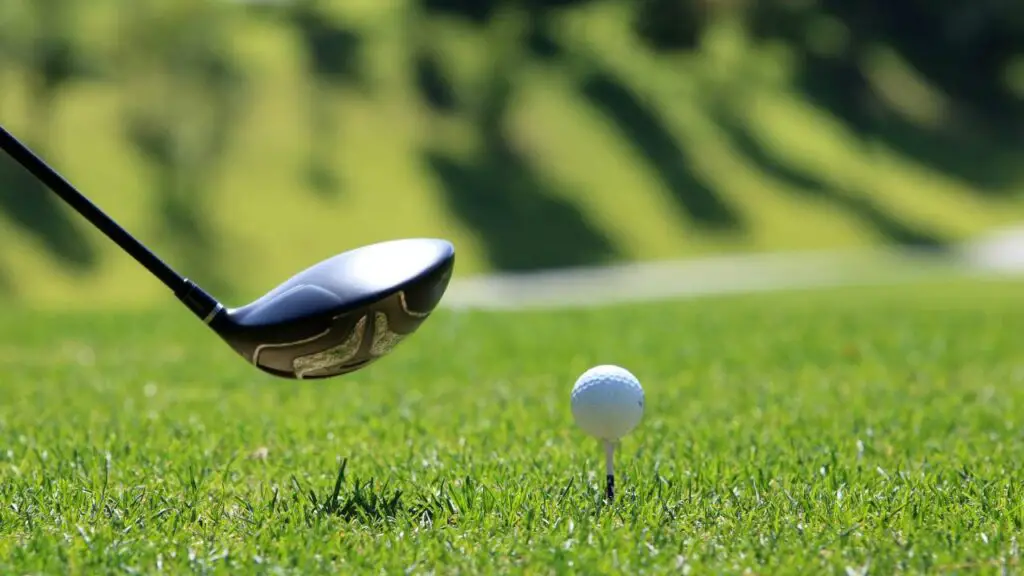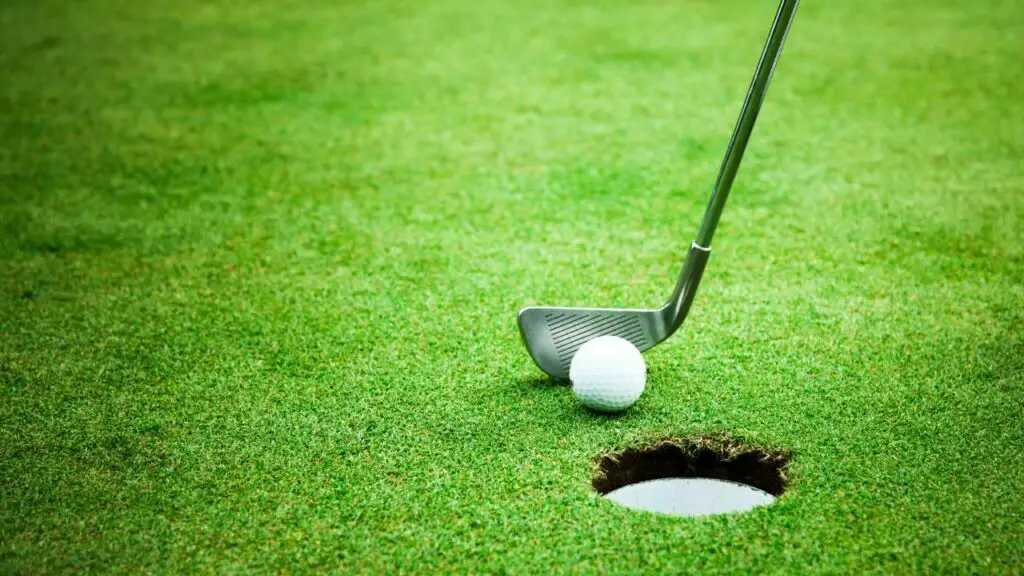What is a Slice in Golf? Understanding the Golf Swing
A slice in golf is a troublesome shot where the ball curves away from your target line due to factors such as weak grip pressure, misaligned stance, and an open clubface at impact. It hampers both shot accuracy and distance, but can be rectified through improved swing techniques, consistent practice, and professional guidance.

Golf is a beautiful game that requires precision, focus, and skill. As with any sport, you are bound to encounter difficulties on the field, and golf is no exception. One of the most common problems that plagues golfers is the slice.
A slice in golf refers to a ball flight path that veers off to the right for right-handed players and left for left-handed players. The term slice in golf can be confusing at first, but it simply means that your ball curves right or left instead of going straight down the fairway toward your target line.
This can be frustrating because it drastically affects your shot’s accuracy and distance.
But what causes a slice in golf?
"A slice in golf refers to a ball flight path that veers off to the right for right-handed players and left for left-handed players. The term slice in golf can be confusing at first, but it simply means that your ball curves right or left instead of going straight down the fairway toward your target line."
There are several factors that lead up to slicing in golf. Weak grip pressure leads to an open clubface during impact. A misaligned stance could cause you not to hit the ball properly square on its face, which then leads to the clubface being open during contact with the ball.
A sliced shot weakens your distance potential as well as your ability to keep up with proper accuracy standards while playing golf shots from the tee box or fairways. There are ways you can improve your swing technique to address this issue.
To help you understand more about slicing in golf and how to fix it, we’ve created this guide to walk you through everything there is to know about slicing: what causes it, how it affects your performance on the course, how to identify if you have a slice problem, expert tips, and exercises for fixing a slice once and for all. Let’s get started!
Check out this video below from Rick Shiels Golf Youtube channel:
Understanding a Slice in Golf
A slice is a common problem that plagues many golfers, both novice and experienced.
Simply put, slicing is when the golf ball curves too much from left to right (for right-handed golfers) or from right to left (for left-handed golfers). For most golfers, this shot can be frustrating and ruin an otherwise good round of golf.
The root cause of slicing lies in the swing path and clubface position at impact. When the swing path of the club moves outside-to-inside (for right-handed golfers), it causes sidespin on the ball, which leads to a slice.
Additionally, when the clubface is open at impact, it accentuates this spin and makes it almost impossible to hit a straight shot. To better understand how a slice occurs, we need to understand how our shoulders play a role in our swing.
Shoulder alignment affects the swing path; if your shoulders are pointing left of your target line at address, then you are more likely to have an outside-to-inside swing path. On the other hand, if your shoulders point right at address, then you are more likely to have an inside-to-outside swing path.
It’s important not to confuse slicing with hooking; while both shots involve sidespin on the ball, they differ in direction. A hook curves too much from right to left for right-handed golfers and from left to right for left-handed players.
"The root cause of slicing lies in the swing path and clubface position at impact."
Golfers should know that fixing a slice requires different techniques than fixing a hook. While some intentional slice shots require curving around obstacles or doglegs on fairways; professional or amateur golfers should want consistency in their shots, so they need to fix slices in their swings as much as possible.
You will find many training drills that focus on grip adjustment or shoulder position correction, specifically geared toward helping those who experience difficulty with slicing shots.
Now that we have an understanding of what a slice is and how it occurs, let’s explore some ways to identify if you are hitting a slice shot.
Enjoying this article? Read more:

Common Causes of a Slice in Golf
When it comes to the common causes of a slice in golf, there are several factors that can contribute to this sweeping curve off the tee.
One of the most significant culprits is an improper clubface position at impact. If your clubface is open or pointing to the right at impact, it will create counter-clockwise sidespin on the ball, resulting in a slice.
Golfers need to ensure they have proper club face alignment at address and throughout their swing.
Another root cause of a slice is shoulder alignment. If your shoulders are aimed left (for right-handed golfers) at address, it will create an outside-to-inside swing path, which can cause a slice. Proper alignment is essential to fix a slice in golf.
Equipment changes can also play a role in causing or fixing slices in golf. If you’re using clubs that are too long or stiff for your swing speed and strength, you may be creating an outside-to-inside swing path that leads to a slice.
Consult with a professional fitter or instructor if you think equipment might be contributing to your slice. Clubface position and alignment are not the only things that can cause slices; how you swipe through impact matters too!
"Golfers need to ensure they have proper club face alignment at address and throughout their swing."
Many amateur golfers tend to come over-the-top on their swings, which means their upper body moves towards the target before their lower body has had time to catch up, leading with their arms instead of initiating from their hips, causing them to leave the clubface open and slicing shots off-target.
Training drills designed explicitly for better swing improvement can help you fix this. There are many potential reasons why you might be experiencing issues with a sliced ball direction when playing golf!
Understanding these common golf slice causes is crucial so that you can begin taking steps towards improving your game by implementing helpful golf slice tips such as proper stance and addressing posture or grip adjustments, along with training drills like working on balance and coordination exercises, while also receiving guidance from a professional to fix slice in golf.

Effects of a Slice on Your Golf Game
A slice in golf can have a significant impact on your game, affecting both distance and accuracy. This unintended direction can result in lost balls, out-of-bounds penalties, and low scores.
Slicing also leads to reduced shot distance since the ball spins excessively off its axis. Many high-handicap golfers suffer from slicing in their golf shots. This is primarily due to setup issues such as poor shoulder alignment or incorrect gripping technique.
For example, players with an open clubface at impact are likely to slice their shots as the clubface produces spin that makes the ball curve right (for right-handed golfers). The effects of slicing in golf are even more pronounced when playing a fade shot or a draw shot. Slicing in golf can also cause mental discomfort for recreational players, who may feel embarrassed by their inability to hit straight shots consistently.
The frustration and pressure often lead them to make unnecessary adjustments during their swing, further worsening their situation on the course. An intentional slice is different from a regular slice as it involves intentionally curving your ball’s direction around an obstacle such as trees or water hazards.
Professional players often use this technique since they have greater control over their shots. However, this should only be attempted after mastering basic swing improvement techniques designed to help prevent slicing in golf.
Overall, slicing in golf has a considerable effect on your game; hence, its importance cannot be overstated. While some cases might need professional help and advice on how best to overcome this challenge, there are several ways you can improve your stance and swing techniques through simple drills and exercises that will undoubtedly help eliminate slicing from your game for good!
How to Identify a Slice in Your Swing
Identifying a slice in your swing can be challenging, especially if you’re not sure what to look for. However, if you know what to look for, it’s possible to identify a slice early on and take steps to correct it.
- One way to identify a slice is by looking at the ball’s direction after contact with the clubface. If the ball starts straight before curving sharply to the right (for right-handed golfers) or left (for left-handed golfers), then it’s likely that you’re hitting a slice.
- Another sign of a slice is an open club face alignment during contact with the ball. This means that the clubface is pointing away from your target, causing the ball to spin sideways.
- Shoulder position can also affect whether or not you’re hitting a slice. If your shoulders are open relative to your target line at impact, this can cause an out-to-in swing path that results in a slicing motion.
- Proper alignment can help prevent this issue, but many golfers struggle with setup issues that cause their shoulders to be out of position.
- It’s also possible for equipment changes to contribute to slicing issues. Using clubs with too much loft or shafts that are too flexible can cause more spin on the ball and lead to slicing problems.
Working with a golf coach or doing research online can help identify which equipment changes may be beneficial for your specific situation.Identifying a slice in your swing requires careful analysis of several factors like setup issues, club face alignment, shoulder position, and ball direction after contact with the clubface.
By paying close attention and working on making improvements through drills and exercises like wiping and sweeping curves, you’ll be able to make progress towards hitting those draw shots instead of frustrating slices.

Proven Techniques to Fix a Slice
Fixing a golf slice is not an easy feat, but it is certainly achievable with the right techniques and practice. There are various techniques that can help you fix your golf slice, ranging from changing your equipment to fixing your swing mechanics.
- One effective method of fixing a slice is by focusing on proper alignment.
Proper alignment involves aligning the body and shoulders towards the target line and positioning the ball in relation to your feet. Recreational golfers tend to overlook this aspect of their setup, leading to a poor swing path and clubface position at impact. When you align properly, you can ensure that your clubface position is square at impact with the ball.
- Another effective technique for fixing a slice is by making equipment changes.
The root cause of a slice could be linked to issues with your clubface or shaft flex. By getting custom-fitted clubs or making small tweaks to existing ones, such as adjusting loft angle or length, you can improve your swing mechanics and reduce sidespin.
- Practice exercises and training drills are also essential in correcting a golf slice.
Working with a golf coach who specializes in correcting slices can provide valuable feedback and instruction on proper swing mechanics. One common training drill for fixing a slice involves hitting draw shots intentionally by using an inside-out swing path and properly aligning the clubface.
"There are various techniques that can help you fix your golf slice, ranging from changing your equipment to fixing your swing mechanics."
- Adjusting clubface position during setup can also help reduce sidespin caused by a poor angle of attack at impact with the ball.
Proper alignment of the club face and its orientation relative to the target line will play an important role in reducing the chances of slicing off course.
Check out this video below from the Danny Maude Youtube channel:
Drills and Exercises to Prevent a Slice
If you’re tired of hitting that pesky slice shot, there are several drills and exercises you can add to your practice routine to help prevent it from happening.
- First, let’s talk about the importance of grip
Many golfers grip the club too tightly with their left hand. This can lead to a slice because it causes the clubface to open during impact. To combat this, try using a lighter grip pressure and making sure your hands are more in the fingers than in the palms. This will allow for a more natural release through impact.
- Another common cause of a slice is an over-the-top swing path
To fix this, try practicing your swing path with an alignment stick or even just an old club shaft. Place the stick or shaft on the ground, pointing toward your target line, and make sure your downswing follows that line from inside to outside. This will help promote a draw instead of a slice spin.
- Shoulder position is also crucial when trying to prevent a slice
Many golfers have their lead shoulder too high at address which can cause them to come over the top on their downswing, leading to that unwanted slice spin. Try lowering your lead shoulder at address which will help promote an inside-to-outside swing path.
Training drills like hitting balls off tees placed outside your target line can help prevent slices by forcing you to come into impact from more inside-to-outside, which promotes counter-clockwise sidespin instead of clockwise which leads to slices.
By implementing these drills and exercises into your practice routine, you’ll be well on your way toward preventing those dreaded slices while out on the course!

Professional Tips and Advice
When it comes to fixing a slice in golf, seeking professional tips and advice can be incredibly helpful. A golf coach can analyze your swing and help you identify any issues that may be causing your slice. They can also provide you with training drills and practice exercises to improve your grip, stance, and swing path.
One tip that many golf coaches suggest for fixing a slice is to adjust your grip. If you tend to slice the ball, try gripping the club a little tighter with your top hand and a little looser with your bottom hand. This will help you better control the clubface through impact and prevent it from opening up too much. Proper alignment is also crucial when it comes to preventing slices in golf. Make sure that your feet, hips, and shoulders are all aligned toward your target line before taking your shot.
This will help ensure that you are swinging along an appropriate path without having to compensate mid-swing.
Learning how to hit a hook shot can actually help fix a slice in golf. A hook shot involves hitting the ball with a sweeping curve from right to left instead of left to right like a slice. By practicing this technique, you can train yourself to close the clubface more at impact and prevent slices from occurring in the future.
Overall, there are many different techniques that professional golfers use to fix slices in their game. Whether it’s adjusting their grip or focusing on proper alignment, taking time to work on these areas during practice sessions can lead to significant improvements on the course.
Conclusion
A slice can be a frustrating and a damaging issue for any golfer. It has the potential to impact your overall game, causing you to miss critical shots and ultimately affecting your score. However, with the right approach, it is fixable.
The key is to identify the root cause of your slice. This could involve analyzing everything from your grip and stance to club face alignment and swing path. Whatever the cause may be, it’s important not to give up or become disheartened with your game.
Instead, focus on making gradual improvements in each area. One effective way to address a slice is by working with a professional who can provide valuable insight into your technique and suggest specific fixes based on your unique swing characteristics.
They may suggest correcting setup issues, such as aligning the body correctly, or making equipment changes, such as adjusting grip or club selection.
Another strategy that can help fix a slice in golf is the consistent practice of drills and exercises designed specifically for this problem. These drills may focus on improving shoulder alignment or promoting an inside-to-outside swing path that counters counter-clockwise sidespin.
Ultimately, fixing a slice in golf requires patience, dedication, and an open-minded approach to adapting new techniques and strategies into your game. With time and hard work, you can master this challenging shot shape and ultimately improve your overall performance on the course!
FAQs
A slice in golf sends the ball curving to the right for right-handers, while a hook makes the ball curve to the left.
Fixing a slice involves correcting grip, adjusting stance and swing path, and potentially altering equipment, often with professional guidance.
Preventing a slice with your driver involves proper club gripping, accurate alignment, and following an inside-out swing path.
Grip your club firmly but not too tight, ensuring that your knuckles on your leading hand are visible, which promotes a square clubface.
The opposite of a slice in golf is a hook, where the ball curves to the left for right-handed players and to the right for left-handers.
To stop irons from slicing, practice aligning your body parallel to the target line, and ensure a smooth, inside-out swing path.
Beginners can correct a slice by adjusting their grip, improving body alignment, and practicing an inside-to-out swing path with slow, controlled swings.
A new driver, especially one with adjustability features, may help minimize slice if it better suits your swing style and speed.
Sudden slicing can be due to changes in your grip, stance, swing path, or even fatigue and lack of focus. An analysis would be helpful.
Yes, drills focusing on grip, stance, swing path, and alignment, such as the “Tee Drill” or “Alignment Stick Drill”, can help rectify a slice.
Share this Post
Toni Benedito
Keep Reading
Follow Us
Recent Posts

How Do Pro Golfers Get Paid? The Business of Golf
Professional golfers get paid both before and after tournaments. Before a tournament, they receive appearance fees, sometimes exceeding $1 million, to attract top players. After the tournament, earnings depend on their placement, with the PGA

How Much Do Golf Players And Pros Make? You Won’t Believe It!
Professional golfers earn substantial incomes through tournament winnings, sponsorship deals, and endorsements. Top players on the PGA Tour can make millions annually, with significant earnings from prize money and lucrative brand partnerships. For example, Rory

The Shocking Cost: How Much Does It Cost to Fly with Golf Clubs?
Flying with golf clubs can be a hassle, but it’s worth it for avid golfers. Costs vary by airline, ranging from $30 to $150 per way. Southwest Airlines offers a generous policy, allowing one set

Why Do Golfers Tape Their Fingers Before Hitting the Course?
Golfers tape their fingers to prevent injuries from repetitive motions, provide support for existing injuries, and improve grip comfort. It’s a popular technique among amateurs and pros alike, offering a lightweight and effective solution compared

How Much Does a Round of Golf Cost? Are You on Par?
The cost of a round of golf varies widely based on factors like course type, location, and time of play. Public courses typically range from $30-$100 per round, while exclusive ones like Augusta National or

Hidden Fees: How Much Does It Cost To Rent a Golf Cart
Wondering how much it costs to rent a golf cart? Explore factors like location, rental duration, and cart type impacting prices. Daily rates range from $50 to $80, while weekly rentals can vary from $200
Table of Contents








